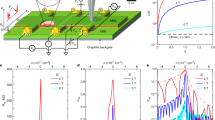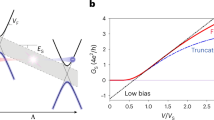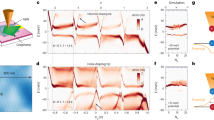Abstract
Relativistic fermions that are incident on a high potential barrier can pass through unimpeded, a striking phenomenon termed the ‘Klein paradox’ in quantum electrodynamics. Electrostatic potential barriers in graphene provide a solid-state analogue to realize this phenomenon. Here, we use scanning tunnelling microscopy to directly probe the transmission of electrons through sharp circular potential wells in graphene created by substrate engineering. We find that electrons in this geometry display quasi-bound states where the electron is trapped for a finite time before escaping via Klein tunnelling. We show that the continuum Dirac equation can be successfully used to model the energies and wavefunctions of these quasi-bound states down to atomic dimensions. We demonstrate that by tuning the geometry of the barrier it is possible to trap particular energies and angular momentum states with increased efficiency, showing that atomic-scale electrostatic potentials can be used to engineer quantum transport through graphene.
This is a preview of subscription content, access via your institution
Access options
Subscribe to this journal
Receive 12 print issues and online access
$209.00 per year
only $17.42 per issue
Buy this article
- Purchase on Springer Link
- Instant access to full article PDF
Prices may be subject to local taxes which are calculated during checkout





Similar content being viewed by others
Change history
26 August 2016
In the version of this Article originally published, refs 30, 32 and 33 were mistakenly cited at the end of a sentence that now reads: 'Such a particle would mimic a massless, spinless particle, and thus could be described by the Klein-Gordon equation9, which has effectively described finite-sized GQD islands31.' This has now been corrected in the online versions of the Article.
References
Klein, O. Die Reflexion von Elektronen an einem Potentialsprung nach der relativistischen Dynamik von Dirac. Z. Phys. 53, 157–165 (1929).
Dombey, N. & Calogeracos, A. Seventy years of the Klein paradox. Phys. Rep. 315, 41–58 (1999).
Katsnelson, M. I., Novoselov, K. S. & Geim, A. K. Chiral tunnelling and the Klein paradox in graphene. Nature Phys. 2, 620–625 (2006).
Cheianov, V. V. & Fal’ko, V. I. Selective transmission of Dirac electrons and ballistic magnetoresistance of n–p junctions in graphene. Phys. Rev. B 74, 041403 (2006).
Pereira, J. M., Mlinar, V., Peeters, F. M. & Vasilopoulos, P. Confined states and direction-dependent transmission in graphene quantum wells. Phys. Rev. B 74, 045424 (2006).
Cheianov, V. V., Fal’ko, V. & Altshuler, B. L. The focusing of electron flow and a Veselago lens in graphene pn junctions. Science 315, 1252–1255 (2007).
Shytov, A. V., Katsnelson, M. I. & Levitov, L. S. Atomic collapse and quasi-Rydberg states in graphene. Phys. Rev. Lett. 99, 246802 (2007).
Shytov, A. V., Rudner, M. S. & Levitov, L. S. Klein backscattering and Fabry–Pérot interference in graphene heterojunctions. Phys. Rev. Lett. 101, 156804 (2008).
Barbier, M., Peeters, F. M., Vasilopoulos, P. & Pereira, J. M. Dirac and Klein–Gordon particles in one-dimensional periodic potentials. Phys. Rev. B 77, 115446 (2008).
Castro Neto, A. H., Guinea, F., Peres, N. M. R., Novoselov, K. S. & Geim, A. K. The electronic properties of graphene. Rev. Mod. Phys. 81, 109–162 (2009).
Vakil, A. & Engheta, N. Transformation optics using graphene. Science 332, 1291–1294 (2011).
Young, A. F. & Kim, P. Quantum interference and Klein tunnelling in graphene heterojunctions. Nature Phys. 5, 222–226 (2009).
Stander, N., Huard, B. & Goldhaber-Gordon, D. Evidence for Klein tunneling in graphene p–n junctions. Phys. Rev. Lett. 102, 026807 (2009).
Lee, G.-H., Park, G.-H. & Lee, H.-J. Observation of negative refraction of Dirac fermions in graphene. Nature Phys. 11, 925–929 (2015).
Hanson, R., Kouwenhoven, L. P., Petta, J. R., Tarucha, S. & Vandersypen, L. M. K. Spins in few-electron quantum dots. Rev. Mod. Phys. 79, 1217–1265 (2007).
Matulis, A. & Peeters, F. M. Quasibound states of quantum dots in single and bilayer graphene. Phys. Rev. B 77, 115423 (2008).
Hewageegana, P. & Apalkov, V. Electron localization in graphene quantum dots. Phys. Rev. B 77, 245426 (2008).
Bardarson, J. H., Titov, M. & Brouwer, P. W. Electrostatic confinement of electrons in an integrable graphene quantum dot. Phys. Rev. Lett. 102, 226803 (2009).
Heinisch, R. L., Bronold, F. X. & Fehske, H. Mie scattering analog in graphene: lensing, particle confinement, and depletion of Klein tunneling. Phys. Rev. B 87, 155409 (2013).
Schulz, C., Heinisch, R. L. & Fehske, H. Electron flow in circular graphene quantum dots. Quantum. Matter 4, 346–351 (2015).
Zhao, Y. et al. Creating and probing electron whispering-gallery modes in graphene. Science 348, 672–675 (2015).
Brown, L. et al. Polycrystalline graphene with single crystalline electronic structure. Nano Lett. 14, 5706–5711 (2014).
Gutiérrez, C. et al. Imaging chiral symmetry breaking from Kekulé bond order in graphene. Nature Phys. http://dx.doi.org/10.1038/nphys3776 (2016).
Sandl, P. & Bertel, E. Surface states, local bonding, and surface reconstruction: Na on Cu (110). Surf. Sci. 302, L325–L330 (1994).
Memmel, N. Monitoring and modifying properties of metal surfaces by electronic surface states. Surf. Sci. Rep. 32, 91–163 (1998).
Lin, C. L. et al. Manifestation of work function difference in high order Gundlach oscillation. Phys. Rev. Lett. 99, 216103 (2007).
Borca, B. et al. Potential energy landscape for hot electrons in periodically nanostructured graphene. Phys. Rev. Lett. 105, 036804 (2010).
Pauly, C., Grob, M., Pezzotta, M., Pratzer, M. & Morgenstern, M. Gundlach oscillations and Coulomb blockade of Co nanoislands on MgO/Mo(100) investigated by scanning tunneling spectroscopy at 300 K. Phys. Rev. B 81, 125446 (2010).
Chang, H. W., Wu, B. F., Yao, Y. D., Su, W. B. & Chang, C. S. Co nanoislands on Au (111) and Cu (111) surfaces studied by scanning tunneling microscopy and spectroscopy. J. Nanosci. Nanotech. 10, 4663–4666 (2010).
Phark, S.-h. et al. Direct observation of electron confinement in epitaxial graphene nanoislands. ACS Nano 5, 8162–8166 (2011).
Hämäläinen, S. K. et al. Quantum-confined electronic states in atomically well-defined graphene nanostructures. Phys. Rev. Lett. 107, 236803 (2011).
Subramaniam, D. et al. Wave-function mapping of graphene quantum dots with soft confinement. Phys. Rev. Lett. 108, 046801 (2012).
Jolie, W. et al. Confinement of Dirac electrons in graphene quantum dots. Phys. Rev. B 89, 155435 (2014).
Zhang, Y. et al. Giant phonon-induced conductance in scanning tunnelling spectroscopy of gate-tunable graphene. Nature Phys. 4, 627–630 (2008).
Natterer, F. D. et al. Strong asymmetric charge carrier dependence in inelastic electron tunneling spectroscopy of graphene phonons. Phys. Rev. Lett. 114, 245502 (2015).
Lee, J. et al. Imaging electrostatically confined Dirac fermions in graphene quantum dots. Nature Phys. http://dx.doi.org/10.1038/nphys3805 (2016).
Acknowledgements
We thank I. Aleiner for helpful discussions. Work at Columbia is supported by the Office of Naval Research (award number N00014-14-1-0501, C.G.) and by the Nanoelectronics Research Corporation (NERC), a wholly owned subsidiary of the Semiconductor Research Corporation (SRC), through the Institute for Nanoelectronics Discovery and Exploration (INDEX) (A.N.P.). Support for microscopy measurements is provided by the Air Force Office of Scientific Research (AFOSR) (award number FA9550-11-1-0010, A.N.P.) and by the NSF through the Columbia Center for Precision Assembly of Superstratic and Superatomic Solids (DMR-1420634, A.N.P.). Work at Cornell University is supported by the NSF through the Cornell Center for Materials Research (NSF DMR-1120296). Additional funding was provided by AFOSR (FA9550-16-1-0106, FA2386-13-1-4118) and the Nano Material Technology Development Program through the National Research Foundation of Korea (NRF) funded by the Ministry of Science, ICT, and Future Planning (2012M3A7B4049887).
Author information
Authors and Affiliations
Contributions
C.G. performed and analysed all STM measurements and theory calculations. L.B. and C.-J.K. performed CVD growth of graphene samples. J.P. supervised the CVD sample growth. A.N.P. supervised STM measurements. All authors participated in writing the manuscript.
Corresponding author
Ethics declarations
Competing interests
The authors declare no competing financial interests.
Supplementary information
Supplementary information
Supplementary information (PDF 1379 kb)
Rights and permissions
About this article
Cite this article
Gutiérrez, C., Brown, L., Kim, CJ. et al. Klein tunnelling and electron trapping in nanometre-scale graphene quantum dots. Nature Phys 12, 1069–1075 (2016). https://doi.org/10.1038/nphys3806
Received:
Accepted:
Published:
Issue Date:
DOI: https://doi.org/10.1038/nphys3806



